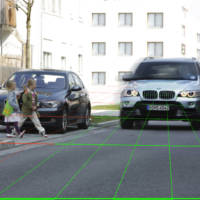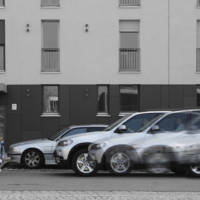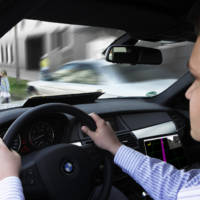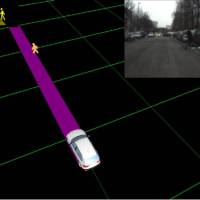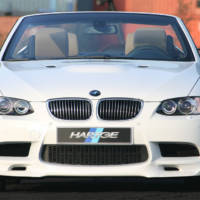BMW together with a few research institutes in Germany, developed a new system under the AMULETT project that will help drivers avoid pedestrians that run into the road from behind parked cars. The name AMULTETT represents the German abreviation for "Active mobile accident avoidance and mitigation of accident effects through cooperative data acquisition and tracking technology” and the system involves vehicles communicating with a radio transponder carried by pedestrians for safety purposes (Car-2-X Communication). Signal emitted by the radio transponder is identified by a 2.4 GHz frequency band multi-antenna system and a processing unit that will recognize even pedestrians that are not in plain view, alerting the driver or even applying the emergency brakes as a last resort.
The three-year BMW AMULETT research project was funded by the Bavarian State Ministry for Economic Affairs, Infrastructure, Transport and Technology and on May 6 the project conclusion will be made public.
BMW press release :
Munich. A child suddenly runs out into the road from between two parked cars – it’s every driver’s nightmare scenario. BMW Group Research and Technology, in collaboration with leading research institutes in Germany, has now developed a system that can take the heat out of such situations thanks to so-called Car-2-X Communication. The research project AMULETT (the German acronym for “Active mobile accident avoidance and mitigation of accident effects through cooperative data acquisition and tracking technology”) involves vehicles communicating with a radio transponder carried, for example, by a pedestrian for purposes of personal safety. Cooperative sensor systems between the car and the transponder mean that even hidden pedestrians can be recognised.
The Bavarian State Ministry for Economic Affairs, Infrastructure, Transport and Technology funded the three-year research project. Alongside BMW Forschung und Technik GmbH, the other participants are Continental Safety Engineering International GmbH, the Fraunhofer Institute for Integrated Circuits, the Institute for High Frequency Engineering at Munich’s Technical University, and ZENTEC GmbH. On 6 May the results of AMULETT will be presented to the public to mark the conclusion of the project.
AMULETT – radio technology for enhanced road traffic safety.
In their AMULETT project, researchers investigated the possibilities of Car-2-X Communication with the aim of improving pedestrian safety. To this end they linked up autonomous on-board systems for driving environment assessment with communication between the car and a transponder carried by a pedestrian or cyclist for their own safety. By means of this cooperative sensor technology, the vehicle exchanges data with the “Amulett”, an active RFID-like (Radio Frequency Identification) element, which could in future be integrated into a schoolbag, a mobile phone or a walking stick, for example.
In detail it works as follows: upon receiving an interrogation impulse from the vehicle, the transponder transmits an identification message. This enables its position to be fixed and, even more importantly, identifies its carrier as a vulnerable road user. It works even if the carrier is not within sight of the driver at the time of danger, for example if the pedestrian is obscured by a parked car or a hedge. The Amulett identifies itself through a code that is frequently changed at random to prevent the carrier being linked to a specific transponder. “In this way we ensure that the user remains anonymous – in compliance with data protection laws – without compromising the prediction of the sensor data,” explains Dr Ralph Rasshofer, AMULETT Project Manager for BMW Group Research and Technology.
The test vehicle identifies the electromagnetic waves using a multi-antenna system in a frequency band of 2.4 GHz, with the angle of arrival and identification determined by a signal processing unit. The distance between the pedestrian and the vehicle is calculated on the basis of the signal’s travelling time between the interrogation from the car and the response from the transponder – essentially the same principle as used in echo sounding. If, on the basis of this data, the system anticipates an impending collision, the driver is given a warning. If the driver does not respond, further measures can be triggered in the car to avoid an accident or mitigate its consequences – and, in the future, emergency braking will be applied as a last resort. “Thanks to AMULETT we will be able to draw very precise conclusions from the sensor data in future. This grants us the possibility of giving road traffic safety another significant boost – because for us, every accident victim is one too many,” adds Rasshofer. In the BMW Group Research and Technology prototype, the driver receives feedback via the Head-up Display, similar to Night Vision with pedestrian recognition already available today. “Part of our development work is to ensure that feedback from driver assistance and information systems is designed in such a way that the driver is on no account alarmed, that it can be intuitively interpreted, and that is will lead to the appropriate response,” says Rasshofer. Ongoing research is thus focused on the exclusion of false alarms (e.g. from AMULETT carriers sitting inside a car) and the system’s evaluation ability when dealing with many carriers – e.g. in city traffic.
The best accident is the one that never happens.
The BMW Group is systematically striving to develop driver assistance and information systems that are targeted at helping motorists to defuse hazardous situations on the road. Here special attention is also directed at the most vulnerable people concerned: pedestrians, cyclists and other non-motorised road users. It explains why BMW is the world’s first car manufacturer to offer BMW Night Vision with pedestrian recognition in the new BMW 7 Series. After all, a large proportion of fatal pedestrian accidents happen at night, many of them on the open road.
But what happens if there is no line of sight between the sensors in the vehicle – in the case of Night Vision those in the thermal imaging camera – and the pedestrian, e.g. in busy daytime traffic? This is precisely what the AMULETT research effort is tackling. Accident statistics repeatedly and unambiguously show that in 40 percent of all fatal pedestrian accidents, the driver does not see the person until just before the impact. In the case of children the situation is even more dramatic. According to the 2006 figures from Germany’s Federal Statistical Office, 48 percent of accident victims between the age of six and 14 ran onto the road without looking out for traffic. 25 percent of accidents involving children happened when they suddenly appeared from behind a visual barrier. “With AMULETT, the research partners have succeeded in taking a further significant step towards raising pedestrian safety in road traffic. Thanks to the improved communications this system provides, road users who are obscured from view can be identified early on and accidents can be prevented,” says Prof. Dr. Dr. Benedikt von Hebenstreit of the Centre of Transport and Safety at Zurich’s University of Applied Sciences.
On 6 May the AMULETT project will be presented to industry specialists and the public during a special event including a programme of talks and a live demonstration. Further information can be found on the homepage www.projekt-amulett.de
Partners in the three-year research project:
BMW Forschung und Technik GmbH is a 100 % subsidiary of BMW AG and is in charge of the following research topics at the BMW Group since 2003: VehicleTechnology, CleanEnergy (hydrogen technology), EfficientDynamics (intelligent energy management/alternative drivetrains), ConnectedDrive (driver assistance /active safety systems) and ITDrive (IT-architecture and communication technology). Being a limited company, legal autonomy from the BMW Group allows a maximum of creativity and flexibility.
An internationally established network, with Technical Offices in the USA (Palo Alto, CA und Clemson, SC) and Japan (Tokyo) as well as Liaison Offices in France (with Eurécom in Sophia Antipolis) and in Germany (with German Research Center for Artificial Intelligence, DFKI GmbH, in Saarbrücken) ensures global access to trends and technologies.
Continental Safety Engineering International GmbH is involved in the AMULETT funded project through its Advanced System Engineering department. The focus here is on active pedestrian protection systems, an area in which Continental Safety Engineering International GmbH develops both sensor systems for detecting potential pedestrian collision and actuator systems to mitigate leg and head impact.
The Fraunhofer Institute for Integrated Circuits IIS carries out research and development work in close collaboration with industry customers and in the fields of digital radio, audio and multimedia technology, digital cinema, design automation, integrated circuits and sensor systems, wired, wireless and optical networks, localisation and navigation, high-speed cameras, ultra fine focus X-ray technology, image processing and medical technology, as well as ICT technologies for the logistics and services sector. For the AMULETT project the Fraunhofer IIS is working on developments for radio localisation systems. One of the focuses is on the miniaturisation of radio technology and rapid signal processing for real-time localisation.
The Institute for High Frequency Engineering at the Technical University of Munich develops and tests components, modules and systems for radar and communication applications. These applications are mainly designed for driving environment assessment systems for cars. The Institute for High Frequency Engineering has for many years also been involved with cooperative sensor systems and networks. Contrary to conventional approaches, the system design is oriented primarily towards optimal measuring quality and only secondarily to the requirements of the communication channel. The result is precise and rapid distance measurements with acceptable communication quality and bandwidth. Work on the AMULETT project included basic research, inter alia, on the use of channelisation codes for distance measurement.
ZENTEC GmbH supports the associated partners in matters of project management and project organisation. As a technology centre in the Bavarian Lower Main region with a longstanding tradition in vehicle safety, ZENTEC assists the project partners in publishing the project results and developing them further.
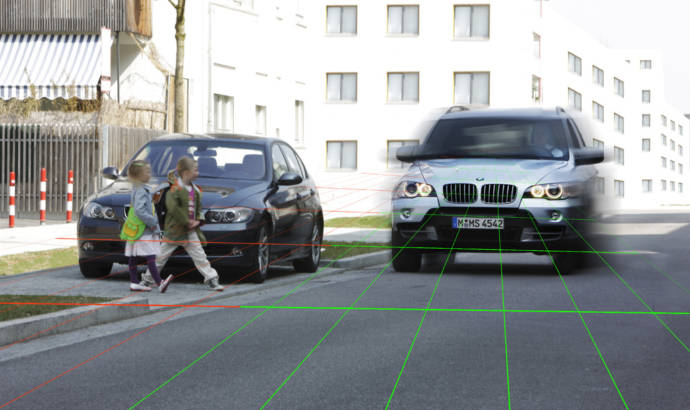
27 Apr 2009
0

